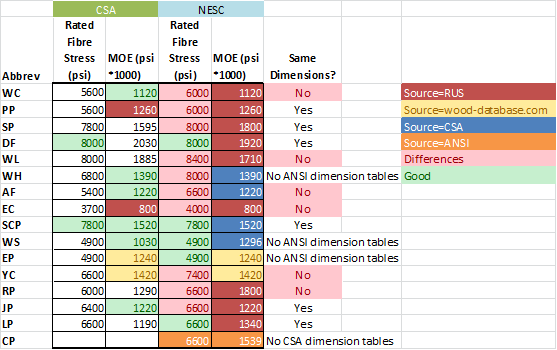Reference Data
Wood Pole Data is used in Quick Pole
 Quick Pole is being sold in both the US and Canada today, which makes it very important that it addresses any differences in standards in those two countries. In particular, the standards related to the classification of poles will be discussed here.
Quick Pole is being sold in both the US and Canada today, which makes it very important that it addresses any differences in standards in those two countries. In particular, the standards related to the classification of poles will be discussed here.
At one time the ANSI O5.1 and the CSA O15 standards were highly aligned. Over time with the inclusion of more pole species and the evaluation of different testing results, these two standards became different. Not only did the rated fibre stress become different in the two standards, but a few pole species started to have different measurements defined for the same pole class. Where many pole manufacturers ship poles across the border, it was always desirable to "Class" a pole the same way so that buyers and designers always knew what they were getting.
This unfortunate reality of different ratings and dimensions for the same class of pole needs to be detected and handled by any Line Design software tool. In Quick Pole this is handled behind the scenes based on the "Line Grade" that is selected for the project. An NESC Line Grade will generate US-based pole parameters while CSA Line Grades will use Canadian values.
The other reality related to US and Canadian standards on wood pole classes is that not all the information is provided that is needed in order to use Quick Pole or any other advanced Line Design software tool. The data that can be missing is the Modulus of Elasticity for the species of wood in the pole. The CSA Standard provides many values (but not all), while the ANSI standard has no recommended values beyond some adjusted values within test results. While some Linear Analysis methods in the past (Groundline moment method...) did not require this value, it is absolutely required for Quick Pole to even do its Linear Analysis on a pole, since it uses Finite Element Analysis for that.
The Modulus of Elasticity is a measure of how flexible or stiff each pole segment is along its length. Knowing this stiffness is critical for any advanced analysis to properly determine the loads that the pole segments, guys and wire attachments will be asked to handle. An assumption for the missing values had to be made in order for Quick Pole to function. While it is thought these are reasonable until the respective standards are updated to suggest new values, the onus is on the Designer to ensure that these are accurate enough to use.


